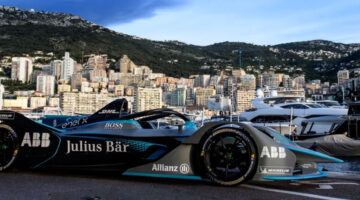Formula E’s fifth season starts in Saudi Arabia on December 15th 2018. And if you’ve yet to give the electric racing series a chance, there’ll be no better time than this year.
With more manufacturer support than ever before, the arrival of drivers from F1 and DTM, and a fundamental change in the way the cars look, perform and last the race, Formula E should continue to build its audience and might even convince a few previous cynics. There are new tracks thrown into the mix too, while the newfound range of the cars will bring an extra strategic element to the sport.
Below you’ll find a rundown of everything you need to know about season five of Formula E – including where to watch it trackside and on TV.

New cars, new rules
The most significant change for the new season is the car itself. Known colloquially as the “Gen 2” car, the new SRT05e chassis is designed by Spark Racing Technology, and will be run by all this year’s teams.
It’s dramatically different to look at, with sleek, futuristic bodywork featuring swooping arches that blur the line for Formula E being an open-wheel series. It also incorporates not just the best integration we’ve yet seen for the FIA’s “Halo” safety system, but also a large rear diffuser that will give the car much of its aero capabilities.
Surprisingly, when compared to the Gen 1 car, the latest cars actually develop less downforce. Teams can run their own motors, transmissions and inverters, but weight is controlled, with the SRT05e coming in at 900kg including a driver. The cars develop up to 335bhp in qualifying trim, and are capable of reaching 100kph in 2.8 seconds. They’ll also now run on until 280kph, up from 225kph, though the increase in weight and decrease in downforce mean cornering speeds may not greatly differ from previous seasons.
The biggest change though is the new battery, designed by McLaren Applied Technologies rather than Williams Advanced Engineering. It contributes 385kg of the car’s weight, up from 320kg, and this hints at its newfound extra capacity. Over the past four years of the series, technology has progressed enough that the new pack has double the capacity of the old one, and that has resulted in a significant race format change too, in that drivers will no longer need to pit to change cars half way through the race.
This will throw up some similarly large changes in strategy. Certainly in recent seasons, small improvements in battery tech meant teams rarely encountered flat batteries and only had a couple of laps during the race where capacity might have been a problem. That kept things relatively simple, but now, each 45-minute race will be fraught with strategic decisions, depending on the pace of competitors, the appearance of full-course yellows, and each driver’s choice of when to use the new performance-boosting “Attack Mode”.
Formula E car specifications
| Spark SRT05e (Gen 2) | Spark SRT01e (Gen 1) | |
|---|---|---|
| Length | 5160mm | 5000mm |
| Width | 1770mm | 1800mm |
| Height | 1505mm | 1250mm |
| Weight (inc. driver) | 900kg | 896kg |
| Battery weight | 385kg | 320kg |
| Max power | 335bhp | 268bhp |
| Race power | 268bhp | 201bhp |
| Max speed | 280kph | 225kph |
| 0-100kph | 2.8sec | 3.0sec |

Teams and drivers
This season will have the greatest number of manufacturer-backed squads yet in Formula E, with Audi, BMW, Jaguar, Mahindra, DS Automobiles, Venturi and Nissan all represented.
The latter takes over from partner Nissan at e.Dams, having bought a stake in the outfit. Nissan claims not just that its racing exploits will help road car development, but also the other way around, bringing the software experience of selling more than 600,000 Leaf road cars to its street circuit-bound racers. Meanwhile, BMW partners the existing Andretti team, while DS has moved allegiance from Virgin Racing to the Chinese Techeetah squad.
New to the series altogether is HWA Racelab. The team might be new to Formula E, but it’s also behind the hugely successful Mercedes-AMG DTM team, and it’s not hard to see why HWA has entered Formula E now, given that Mercedes aims to enter the sport in the 2019-20 season.
HWA also brings an experienced driver lineup to the team, with ex-F1 driver Stoffel Vandoorne, and existing HWA DTM driver, Gary Paffett. Most other teams have retained their 2017-18 lineups for the latest season, the most significant new driver being the hugely experienced Felipe Massa, who joins Venturi.
A couple of teams are yet to reveal their full driver lineup, while Nissan e.Dams’ pair hangs in the balance as we go to press, with new signing Alex Albon looking like he may be snatched up by the Toro Rosso F1 team for 2019.

| Team | # | Driver | Natl. | FE wins | ||
|---|---|---|---|---|---|---|
| Audi Sport ABT Schaeffler | 1 | Lucas di Grassi | BRA | 8 | ||
| 66 | Daniel Abt | DEU | 2 | |||
| BMW i Andretti Motorsport | 28 | Antonio Felix da Costa | PRT | 1 | ||
| TBC | Alexander Sims | GBR | 0 | |||
| Envision Virgin Racing | 2 | Sam Bird | GBR | 7 | ||
| TBC | Robin Frijns | NLD | 0 | |||
| Geox Dragon | 6 | Jose Maria Lopez | ARG | 0 | ||
| TBC | – | – | ||||
| Panasonic Jaguar Racing | 3 | Nelson Piquet Jr. | BRA | 2 | ||
| 20 | Mitch Evans | NZL | 0 | |||
| Mahindra Racing | 7 | Jerome D'Ambrosio | BEL | 2 | ||
| TBC | – | – | ||||
| NIO Formula E Team | 16 | Oliver Turvey | GBR | 0 | ||
| 4 | Tom Dillmann | FRA | 0 | |||
| DS Techeetah Formula E Team | 25 | Jean-Eric Vergne | FRA | 5 | ||
| 18 | Andre Lotterer | DEU | 0 | |||
| Venturi Formula E Team | 4 | Edoardo Mortara | CHE | 0 | ||
| 5 | Felipe Massa | BRA | 0 | |||
| Nissan E.Dams | 9 | Sebastien Buemi | CHE | 12 | ||
| 22 | Alex Albon | THA | 0 | |||
| HWA Racelab | TBC | Stoffel Vandoorne | BEL | 0 | ||
| TBC | Gary Paffett | GBR | 0 |

Circuits
Formula E’s fifth championship will again be almost a season of two halves, with a series of “emerging market” rounds at the start, followed by European and American events from around the season’s mid-point. Newest of those emerging markets is round one in Ad Diriyah, Saudi Arabia, a town on the outskirts of Riyadh. With 21 turns it’s among the twistiest tracks on the calendar, but its December 15th slot should keep the Middle East’s crippling heat to a minimum.
Also new is the appearance of a track in Sanya, China. While Formula E has visited China before (and will return to Hong Kong in 2019) Sanya’s resort-style surroundings, relatively small population and position as one of China’s southernmost cities are almost literally a world away from the polluted northern metropolis of Beijing from seasons one and two. A circuit layout hasn’t yet been revealed, but a picturesque waterfront layout is likely.
Another city layout yet to be confirmed is that of Bern in Switzerland. Formula E visited Zurich last season – the first high-level circuit race in the country for six decades – so Formula E’s message should again fit right in with the notoriously motorsport-averse country.
Formula E 2018-19 race calendar
| Round | Country | Venue | Circuit length | Date |
|---|---|---|---|---|
| 1 | Saudi Arabia | Al Diriyah | 2.50km | 15 Dec 2018 |
| 2 | Morocco | Marrakesh | 2.99km | 12 Jan 2019 |
| 3 | Chile | Santiago | 2.46km | 26 Jan 2019 |
| 4 | Mexico | Mexico City | 2.09km | 16 Feb 2019 |
| 5 | Hong Kong | Hong Kong | 1.85km | 10 Mar 2019 |
| 6 | China | Sanya | TBC | 23 Mar 2019 |
| 7 | Italy | Rome | 2.84km | 13 Apr 2019 |
| 8 | France | Paris | 1.90km | 27 Apr 2019 |
| 9 | Monaco | Monte Carlo | TBC | 11 May 2019 |
| 10 | Germany | Berlin | 2.38km | 25 May 2019 |
| 11 | Switzerland | Bern | TBC | 22 Jun 2019 |
| 12 | USA | New York City | 2.37km | 13 Jul 2019 |
| 13 | USA | New York City | 2.37km | 14 Jul 2019 |




